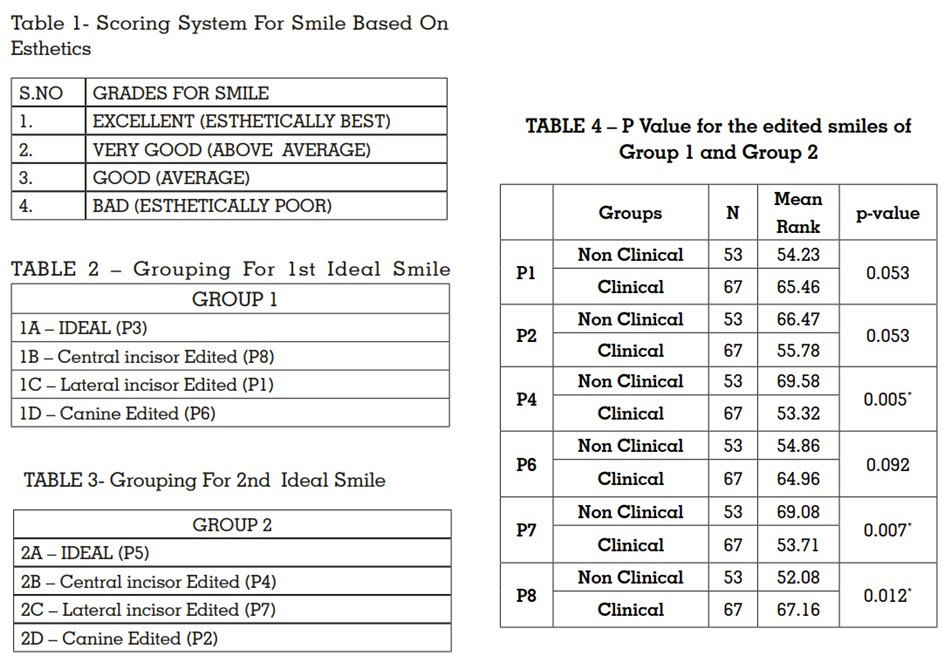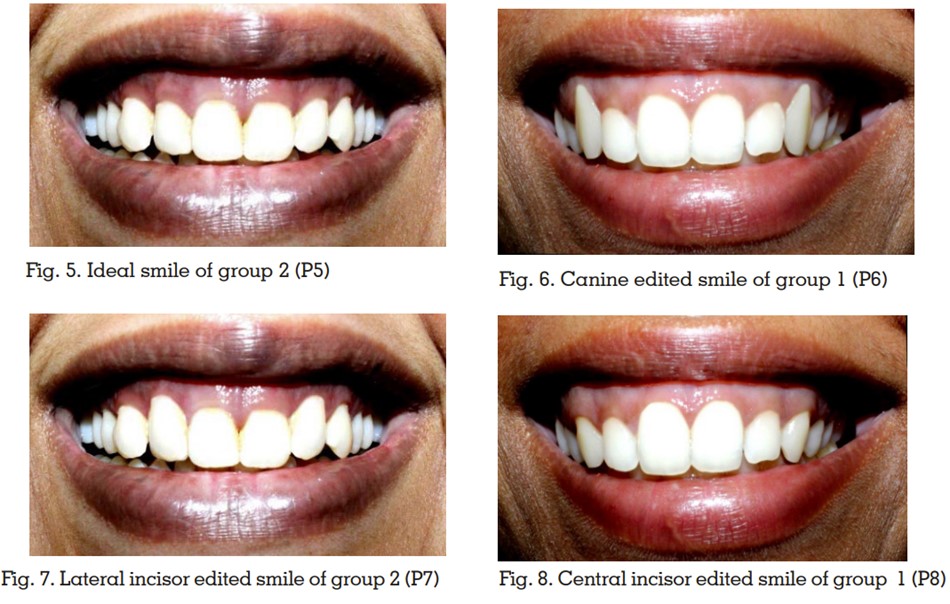

Aim: To examine the influence of gingival esthetics
on the esthetic perception of wide smile; as when
the subject smiles more openly exposing the gingiva
and how it is esthetically appreciated by the common
people and to correlate the gold standard criteria
(Gingival zenith alignment is considered gold
standard here) with the manipulated gingival
esthetics.
Materials & Methods: 50 clinical and 50
nonclinical students, a total of 100 students were
involved in the study to score the esthetics of the
smile photographs shown to them.
Results: clinical
and non clinical students were not able to find
all the manipulated smiles as unesthetic smile.
Conclusion: Gold standard factors like Gingival
zenith doesn’t always play an important role in
determining esthetic smile.
Key words: esthetics, gingiva, smile
To express happiness in life, smile is an essential
factor. To make that smile look elegant, so many
esthetical factors are taken into consideration.
Gingival esthetics is one among the important factors that can influence smile. There are less
evidence based on this correlation between
gingival esthetics and wide smile. Some smiles
are very pleasing even when they do not follow
the gold standard criteria. It should be assessed
that whether people can appreciate that as a
pleasing smile even if the gold standard is not
met.
Common people have no idea and knowledge
on esthetic factors. Non clinical students
whose knowledge in the esthetic factors are
comparatively less than the Clinical students
were selected to get non biased results. A total
of 100 students of which 50 from 1st, 2nd year (non
clinical) B.D.S and 50 from 3rd, 4th year (clinical)
B.D.S are involved in the study. Each student is
asked to be seated at a standard distance from the
monitor and for each student 8 photographs were
projected randomly and, out of which 2 photos
have ideal smile and 3 manipulated photos
for each ideal smile.1,2 A scoring system was
made for rating the smiles (Table 1) & students
were asked to rate the smile according to their
perspective of esthetics. Scoring for each smile was recorded in the excel sheet and statistics
were interpreted. To avoid confusion, the smile
photographs were named and tabulated (Table
2,3) for analysis. Fig 1,2,3,4,5,6,7,&8 shows the
ideal and edited smile photographs used in this
study. The data analysis was done using the
SPSS Version 22Software, IBM Statistics, USA
using Mann- Whitney Test.

For P1, P6, P8 non clinical students gave the
score more towards the excellent smile, clinical
students gives more towards the poor smile. For
P2, P4, P7, non clinical students gave the score
more towards the poor smile, clinical students
gives more towards the excellent smile. Table
4 gives the statistical data for the study. While interpreting the statistical data, it was found that
the clinical students are able to find the difference
between ideal and edited smiles only in half of
the samples. And the non clinical students, are
not able to find the difference between ideal and
edited smiles in half of the samples The ability
to find the difference in the smiles between the
clinical and non clinical students is clinically not
much significant.


Ideal smile highly relies on symmetry and
balance of facial and dental features. Gingival
esthetics is one among them. Gingival zenith
is the most highest point of gingival margin3.
Although the gingival zenith seems to be very
small factor, it greatly influences the smile4.
The amount of gingival display of the patient
is also important parameter for esthetics of the
patient.5,8 The perception of esthetics differs for each common person and is not equivalent to
the professional’s knowledge about esthetics.6
To correlate esthetic relation with various
gingival zenith levels, photographs with high
gingival display and wide smile were taken7.
Gingival zenith levels were modified between
maxillary central incisors, lateral incisors
and canine on both sides of arch and given to
dental U.G clinical and non clinical students
for analysis of esthetic smile, to prove whether
that gold standard criteria’s for esthetic smile
is really always important for the good looking
pleasant smile2. On interpreting the results, it
is evident that nonclinical students are able to
appreciate the difference between the ideal
and manipulated smiles to some extent and
clinical students are not able to appreciate the
difference between the ideal and manipulated
smiles to certain extent.
After, this study on the influence of gingival
esthetics on the aesthetic perception of wide
smile it was concluded that, There is no significant
difference between the clinical and non clinical
students in finding the difference between the
ideal and manipulated smiles. The gingival
factors have less influence on the esthetics
of the smile when a person smiles widely. The gold standard criteria for esthetic smile may
be important but not all the time because the
esthetic perception may vary among individuals.